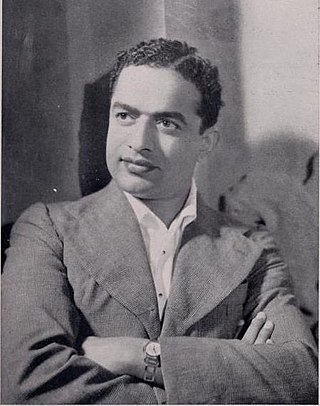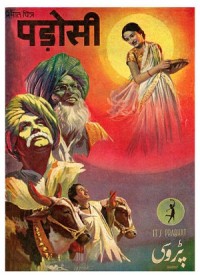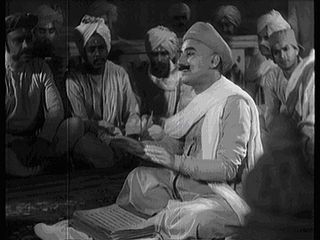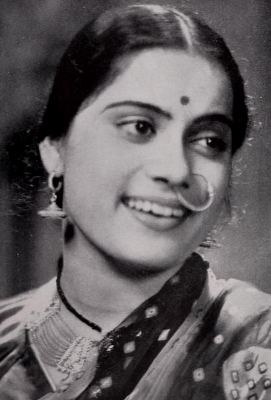A list of films produced by the Marathi language film industry, based in Maharashtra in the year 1933.
A list of films produced by the Marathi language film industry, based in Maharashtra in the year 1933.
A list of Marathi films released in 1933.
| Year | Film | Director | Cast | Release Date | Production | Notes | Source |
|---|---|---|---|---|---|---|---|
| 1933 | Sinhagad | Rajaram Vankudre Shantaram | Keshavrao Dhaiber,Ganpat G. Shinde,Shankarrao Bhosle,Bazarbattoo,Baburao Pendharkar,Budasaheb, Master Vinayak,Leela,Prabhavati | Prabhat Films | Based on Hari Narayan Apte's literary classic novel "Gadh Aala Pan Sinha Gela" | [1] | |
| Sairandhri | Rajaram Vankudre Shantaram | Shakuntala Paranjpye, Master Vinayak, Leela, G.R. Mane, Shankarrao Bhosle | Prabhat Films | Based on an incident from the Mahabharata | [2] |

Tanhaji Malusare was a warrior and commander of Shivaji. A local poet Tulsidas, wrote a powada describing Subhedar Tanhaji's heroics and sacrifice of life in the Battle of Sinhagad, which has since made him a popular figure in Indian folklore.

Shantaram Rajaram Vankudre, referred to as V. Shantaram or Shantaram Bapu, was an Indian filmmaker, film producer, and actor known for his work in Hindi and Marathi films. He is most known for films such as Dr. Kotnis Ki Amar Kahani (1946), Amar Bhoopali (1951), Jhanak Jhanak Payal Baaje (1955), Do Aankhen Barah Haath (1957), Navrang (1959), Duniya Na Mane (1937), Pinjara (1972), Chani, Iye Marathiche Nagari and Zunj.

Keshavrao Date (1889–1971) was an Indian film actor, who worked in both silent and sound movies. He tried to run his own drama company but found it difficult to perform the dual roles of manager and actor.

Jayshree Gadkar was a noted Marathi and Hindi movie actress and a star of Marathi cinema from the 1950s up to the 1980s.

Ajay-Atul is an Indian music composer duo comprising brothers Ajay Ashok Gogavale and Atul Ashok Gogavale. They won the Best Music Direction award at the 56th National Film Awards from the Government of India for their music in the Marathi film Jogwa in 2008. They made their debut in the 2015 Forbes India Celebrity 100 List securing a position of 82 and were placed 22nd in 2019. They have composed music for many hit Marathi & Hindi films.

Uttara Baokar was an Indian stage, film, and television actress. She acted in several notable plays, such as Padmavati in Mukyhamantri, Mena in Mena Gurjari, Desdemona in Shakespeare's Othello, the mother in playwright Girish Karnad's Tughlaq, the nautch girl in Chhote Saiyad Bade Saiyad, and the lead role of Umrao in Umrao Jaan. In 1978, she directed Jaywant Dalvi's play Sandhya Chhaya, translated to Hindi by Kusum Kumar.
Shivaji, was the founder of the Maratha Empire in India. He is considered a prominent historical figure in India. A number of films, books, plays and television serials have been produced about his life and about figures associated with him.
Restaurant is a Marathi language movie. It is the debut film of director Sachin Kundalkar.
Khwab Ki Duniya (transl. Dreamland) is a 1937 Hindi fantasy film produced and directed by Vijay Bhatt for Prakash Pictures. The music director was Lallubhai Nayak with lyrics written by Pandit Anuj. The film starred Jayant, with costars Sardar Akhtar, Umakant, Zahur, Lallubhai, Shirin and Ismail.
Netaji Palkar is a 1927 Indian biopic historical silent film directed by V. Shantaram. Kaishavrao Dhaiber who was an apprentice with Damle, co-directed the film. He was to become the chief cinematographer for Shantaram in his later films. Made under the Maharashtra Film Company, Kolhapur, it was the first film directed by Shantaram. The director of photography was S. Fattelal and the cast included Ansuya, Balasaheb Yadav, Ganpat Bakre and Zunzarrao Pawar.

Chandrasena is a 1935 Hindi/Marathi mythology drama film directed by V. Shantaram for his Prabhat Film Company. The film was the first Indian trilingual film to be made simultaneously in Hindi, Marathi. The cinematographer was K. Dhiaber and the story and dialogue were by Shivram Vashikar. The music direction was by Keshavrao Bhole, with lyrics written by K. Narayan Kale. The cast included Nalini Tarkhud, Sureshbabu Mane, Kelkar, Rajani, Shantabai and Azurie.

Shejari is also known as Padosi in Hindi version as. Padosi is a 1941 Indian social drama film directed by V. Shantaram. It was produced by Prabhat Film Company and the bilingual film in Marathi and Hindi was the last film Shantaram made for Prabhat before venturing to form his Rajkamal Kalamandir. The film is cited as one of the three social classics Shantaram made at Prabhat. The other two were Duniya Na Mane (1937) and Aadmi (1939). The story and dialogue were by Vishram Bedekar in the Marathi version, while the dialogues in the Hindi version were by Pandit Sudarshan, who also wrote the lyrics. The music director was Master Krishnarao. The famous character artist Radhakrishan made his acting debut in the film as a villain. The film starred Mazhar Khan, Gajanan Jagirdar, Anees Khatoon, Radha Kishan, Lajwanti, Sumitra, Gopal and Balak Ram.

Sinhagad is a 1933 Marathi historical fact film directed by V. Shantaram. The production company was Prabhat Film Company. The story was based on Hari Narayan Apte's literary classic novel "Gad Ala Pan Sinha Gela". Apte was a famous Marathi novelist of the early twentieth century. The story's screenplay and dialogue were written by Narayan Hari Apte. The cinematographers were V. Avadhoot and Keshavrao Dhaiber. The cast included Master Vinayak, Baburao Pendharkar, Keshavrao Dhaiber, Leela Chandragiri, Shinde, Prabhavati, Budasaheb and Shankarrao Bhosle.

Dharmatma is a 1935 Indian social devotional biopic directed by V. Shantaram. The film was a bilingual made in Marathi and Hindi. This was the only devotional film directed by Shantaram, though he had made several mythological films. The story and screenplay were by K. Narayan Kale and the music was composed by Master Krishnarao. The cast included Bal Gandharva in his debut role and Chandra Mohan as the villain, with Master Chhotu, K. Narayan Kale, Ratnaprabha, Vasanti and Hari Pandit.

Manoos, also called Life's for Living, is a 1939 Indian Marathi social melodrama film directed by V. Shantaram. The movie was simultaneously made in Hindi as Aadmi. The film was based on a short story called "The Police Constable". The story was by A. Bhaskarrao, with screenplay and dialogue by Anant Kanekar. The cinematographer was V. Avadhoot and the music was composed by Master Krishna Rao, with lyrics by Kanekar. The cast included Shahu Modak, Shanta Hublikar, Sundara Bai, Ram Marathe, Narmada, Ganpatrao and Raja Paranjpe.

Shanta Apte (1916–1964) was an Indian actress-singer who worked in Marathi and Hindi cinema. Renowned for her roles in films like Duniya Na Mane/Kunku (1937) and Amar Jyoti (1936) under the Prabhat Films banner, she was active in Indian cinema from 1932 to 1958. Apte's impact on Marathi cinema "paralleled" that of Kanan Devi in Bengali cinema. Along with Kanan Devi, Apte is cited as one of the "great singing stars" from before the playback singing era. Apte began her career in films playing the role of a young Radha in the Marathi film Shyamsunder (1932). She joined Prabhat Films acting in her first Hindi language film Amrit Manthan in (1934).

Sairandhari (सैरंध्री) a 1933 Indian film based on an episode from the Mahabharata and directed by V. Shantaram. The film was a bilingual made as Sairandhari in both Marathi and Hindi. Produced by Prabhat Film Company, it has been cited as one of the 21 "most wanted missing Indian treasures" by P K. Nair, the National Film Archive of India founder. The music composer was Govindrao Tembe. The cast included Master Vinayak, Leela, Prabhavati, Shakuntala, G.R. Mane, Nimbalkar and Shankarrao Bhosle.

Krishnaji Ganesh Phulambrikar (1898–1974), popularly known as Master Krishnarao, was a musical genius - an Indian vocalist, classical musician and composer of Hindustani music. He was credited with the creation of three Hindustani ragas and several bandishes. Phulambrikar, a recipient of the Sangeet Natak Akademi Fellowship, was also the music composer of several movies, including Dharmatma, a 1935 Hindi film starring Bal Gandharva, a renowned Marathi singer and Padosi, a 1941 directorial venture of V. Shantaram. The Government of India awarded him the third highest civilian honour of the Padma Bhushan, in 1971, for his contributions to music.